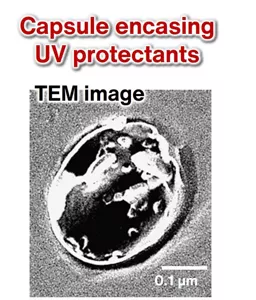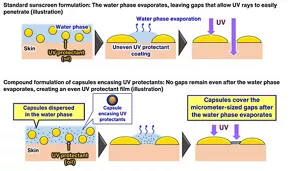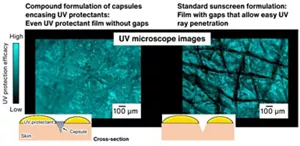Uniform and Even Coating for UV Protection With Surface-Structure Regulating Capsules
UV Care
Ultra-violet (UV) rays that comprise part of sunlight can cause sunburn, as well as spots and wrinkles as aftereffects. To effectively protect the skin against a sunburn from UV rays, it is important to cover it uniformly and evenly with a sunscreen.
Kao has developed a technique to improve the uniformity at the micrometer level to achieve highly effective UV protection.
Many UV filters in sunscreen formulations are molecules that are soluble in oil. This means that in O/W (oil in water)-type emulsions, the oil phase can protect against UV rays, but the water phase evaporates and leaves gaps that let UV rays penetrate to the skin. Even if water-soluble UV filters are added to the emulsion’s water phase, the problem remains that they dissolve in water and are therefore easily washed off by sweat or water.
At Kao, we developed a capsule formulation with solid lipids that have affinity for both water and oil. These encase oil-soluble UV filters inside to create microcapsules. We then created a sunscreen formulation in which these microcapsules are dispersed throughout the water phase, so that even when the water phase has evaporated, the UV filters still cover the gaps. This creates a uniform coating of UV filters, preventing uneven application at the micrometer level.
In addition, we developed a technique for recording UV reflection images to measure the UV rays that are reflected off the sunscreen film. This technique makes it possible to do rapid image-based analysis of the efficacy of invisible sunscreens.
Kao will apply these technologies to developing sunscreen formulations with high UV protection that our customers can use in with ease every day.

TEM image of a capsule encasing UV filters


- Home
- Innovation
- Research & Development
- Product Development Research
- Skin Care
- Uniform and Even Coating for UV Protection With Surface-Structure Regulating Capsules
- Home
- Innovation
- Research & Development
- Product Development Research
- Skin Care
- Uniform and Even Coating for UV Protection With Surface-Structure Regulating Capsules
